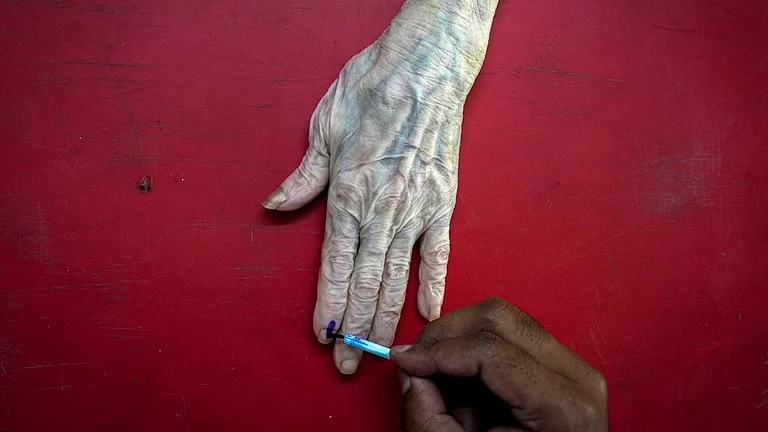They arrived at India’s ‘spiritual capital’, Rishikesh, 54 years ago. The Beatles went on to explore India’s rich spiritual heritage, passionately practising meditation in a perfect Himalayan setting—a deep forest on a small hillock on the eastern banks of the Ganges.
They played their guitars, wrote 48 iconic songs and sent countless postcards to their overseas friends. Their presence put India on the top of the world tourism map.
At least one of them—John Lennon—gave the finishing touches to his romance, with the Japanese multimedia artist Yoko Ono.
They wore Indian clothes, while the women accompanying them, including Cynthia Lennon, John’s first wife, donned saris and bindis all through their stay at the sprawling 14-acre ashram of Maharishi Mahesh Yogi—known worldwide for his movement called Transcendental Meditation. They ate vegetarian food and sat for long meditation sessions. Yogi is said to have invited the band to change the West’s attitude toward Indian spirituality and his Transcendental Meditation.
The event caught global media attention as Lennon, McCartney, Harrison and Starr arrived in February 1968 at the Maharishi’s ashram. Many recall that Rishikesh was little more than a village then, with a population of 20,000 or 30,000, which has now bloated up into an overgrown township.
‘Chaurasi Kutiya’ (84 caves)—the bungalow where the Beatles stayed inside the erstwhile ashram, now part of Rajaji National Tiger Reserve—is in ruins, decayed by time. Most of the landmark buildings, living spaces, and meditation caves—igloo-shaped enclosures, built using sand and stones lugged from the Ganga’s banks—have crumbled. Shrubs, bushes and uprooted/fallen trees have overrun the complex—a sign of neglect and poor upkeep.
Recently, when award-winning British photographer Michael Donald exhibited his photographs during a trip to Rishikesh, in which he captured the Beatles bungalow in its utter neglect, the legacy of the Beatles returned to haunt the town. Donald was on his first visit to Rishikesh when he came to know of the Beatles bungalow.
The splendour of the buildings, which were once a hub of activity, music and spiritual teachings, is now bereft of doors, windows and fittings. Few have signages on the large awnings, declaring them to be unsafe.
Admits Dehradun-based journalist Raju Gusain, “Neither the UP government nor its heir, the Uttarakhand government, ever made any attempt to save this heritage. It’s in complete neglect. Right now, it’s looked after by the forest department but it has no plans for its conservation.”

Gusain, whose curiosity about the Beatles’ stay at Rishikesh took him all the way to England, has a treasure trove of trivia. It has led many top filmmakers, like two-time Emmy Award-winning Canadian Paul Saltzman, to him and the Beatles’ stay at the ashram.
“Many people may not be aware that Cynthia Lennon’s arrival and her stay with John Lennon at the bungalow were aimed at saving her marriage. Evidently, she failed. After initially sharing a room with John, she shifted to a separate room,” Gusain claims.
Meanwhile, John’s love story with Yoko Ono blossomed. He used to write letters to her, mainly postcards, almost regularly. He also kept receiving her responses.

The post office, another landmark building at the ashram, is witness to their story.
Being allergic to most of the food served at the ashram, Ringo Starr left early, while other members stayed over for 5-8 weeks.
There is an interesting twist to their stay at the bungalow, especially when Prudence Farrow, actress Mia Farrow’s sister, arrived. She used to do long meditation sessions that lasted for hours, in complete seclusion. The famous Beatles song, Dear Prudence, was dedicated to her. It was written by John Lennon to coax her out of her seclusion.
Some other songs written at the meditation centre include Let it go, as well as much of the albums White Album and Yellow Submarine.
It was due to the effort of Gusain, along with Paul Saltzman, Tony Ellis, Raja Richard Ross, Anand Shrivastava and Laxman Shrivastava, that a photo gallery based on the Beatles’ stay was set up in 2018, during the 50th year of their arrival at the ashram.
“There are 22 photographs, all of the rare value, on display at the galley. The building where the galley is located was restored to its original form to give a decent look and is now visited by tourists, mostly foreigners, every day,” Gusain says. But many other iconic buildings are on the verge of collapse.
The Beatles, during one of their trips to Dehradun, also visited the music store Pratap Music House, and befriend its owner (late), Ajit Singh, a fine Vichitra Veena player, whom they invited to their home for a musical retreat, recalls his sister Brijpal Aneja, who now looks after the store.
The most fascinating places in the entire complex are 84 Kutiya and an adjacent hall. Half of the latter is underground and contains private mediation caves made of small stones and concrete.
The bungalow with seven rooms where the Fab Four stayed used to have running water, electricity and proper ventilation, though they reportedly used to take daily dips in the Ganga.
At the Artist’s Studio, one can see paint peeling off, broken cement patches and fading life-size graffiti of the band members with the Maharishi, amidst broken windows, doors and a cracked roof. Brightly coloured murals on the walls are partially disfigured. The printing press, where Maharishi used to get all his publications printed, has disappeared. A bathroom at the Beatles’ bungalow with a ceramic bathtub, is abandoned. Maharishi’s own bungalow and the Dnyanpeeth are also in ruins.
Rajender Nautiyal, the forest officer who was instrumental in getting the 84 Kutia opened to the public in December 2015, says, “A great deal of effort had been put in to save the world heritage site.”
The ashram’s lease expired in 1981. In 2003, the complex came under the jurisdiction of Rajaji National Park. “After the lease expired and it got notified within the tiger reserve, the forest department shut down its gates, refused entry to visitors but took no steps to preserve the land, buildings artefacts and assets. Anyone could sneak into the place from nearby villages and take away whatever they found. From doors and windows, even valuable furniture and rare photographs and books were stolen,” he recalls. No one bothered to stop the loot and destruction.

"Serving as a Forest Range Officer, it was painful to see the relics disappearing," says Nautiyal. Most international celebrities, filmmakers, foreign dignitaries and people associated with the band used to come searching for the place, but returned disappointed, he adds.
“I somehow motivated them to write emails to the government, asking it to intervene and save the legacy. Finally, the Uttarakhand government decided in 2015 to open the bungalow to the public. I involved several foreign writers and filmmakers to write and erect proper signages for each building, for the benefit of visitors,” he recalls.
Nautiyal, having already been posted out to Tehri, wonders if any further effort has been made to take things forward from where he had left.
The opening of the bungalow became a huge event, attracting media attention the world over.
During the Beatles’ stay over, a tiger was shot within the ashram, an act the band members totally disapproved of. The incident inspired their song “Continuing story of bungalow bill”, Nautiyal claims.
Uttarakhand tourism minister Satpal Maharaj tells Outlook that he has written a letter to PM Modi, seeking his attention for promoting ’84 Kutia’ as a world heritage site. “Within the government, I’ve discussed the issue with forest minister Subodh Uniyal, for working out a plan to develop it as a tourist destination, apart from undertaking necessary preservation works,” he says.
Forest officials claim the department earns around Rs 1 crore a year from the entry fee. Foreigners are required to pay a higher Rs 600 per person compared to Rs 150 for Indians.


























